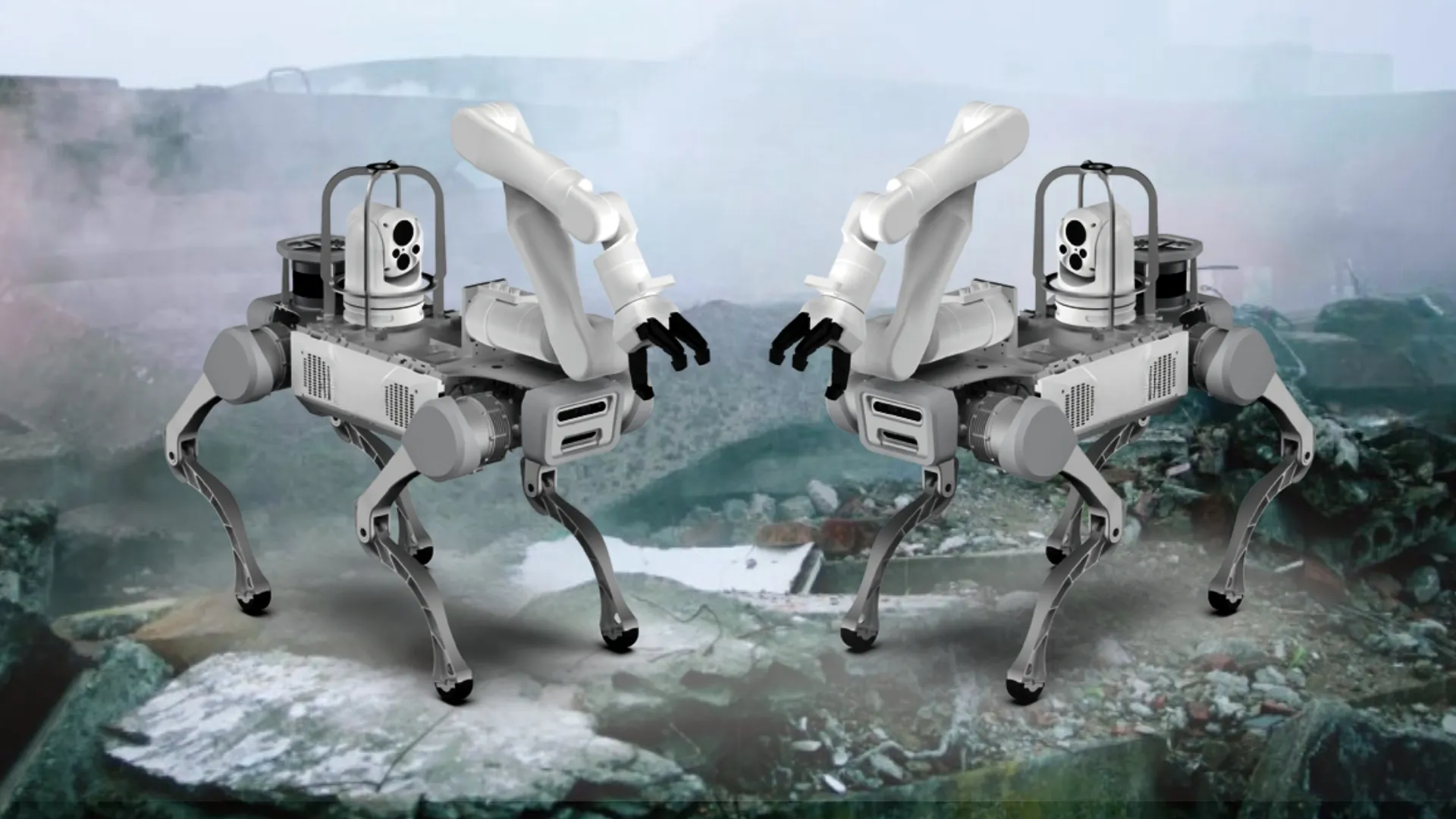Indice dei contenuti
ToggleThey don't move in packs, but they can interact and integrate with each other. They don't bark, they don't bite and they won't make eyes at you, but we assure you that they can still be considered the best friends of man, and of business.
We're talking about Robot dogs, “quadrupedal” mechanical devices designed to look and behave similarly to a real dog but developed for a variety of purposes.
These can range from assistance to operational-work tasks of all kinds, and even for military use.
Robot Dogs, in fact, are equipped with a combination of advanced technologies, includingartificial intelligence, vision systems, sensors of various kinds and a good dose of sound mechanical engineering; all components that allow them to perceive the surrounding environment, interact with it and carry out specific tasks.
Regarding their physical structure, robot dogs vary greatly depending on the manufacturer and specific purpose: some models are designed to resemble real dogs, with movable joints and a very realistic appearance; others may be more stylized and have a more mechanical structure.
The key component that allows Robot Dogs to work, however, is artificial intelligence.
Thanks to the use of machine learning algorithms, these robots can analyze and adapt to their surroundings, using sensors (including cameras, microphones, gyroscopes, accelerometers and touch sensors) to detect sounds, movements, obstacles and, ultimately, interact with their surroundings.
But above all, artificial intelligence allows them to perform complex tasks, such as recognizing objects or people, navigating complex environments, and interacting with humans.
Finally, although some Robot Dogs can be controlled via a remote control, the more advanced ones they operate autonomously using, coincidentally, their sensors and artificial intelligence.
But what are the fields of application of this extraordinary new frontier of robotics? Let's look at some of them together.
Logistics and delivery
Robot dogs can be used in logistics and in the delivery sector in various ways, but always guaranteeing automation capable of improving the efficiency, precision and safety of logistics operations.
A Robot Dog, in fact, can first and foremost be programmed to perform autonomous deliveries. Equipped with advanced navigation and mapping sensors, it can follow predetermined routes to deliver packages or goods to certain areas.
This makes it suitable for environments such as warehouses, campuses or corporate complexes to automate the delivery process.
But in this context the applications are truly vast.
Think about it monitoring of shipments, through the detection, tracking and cataloging of parcels. And even load management, equipping the Dog with a mechanical arm or other equipment to lift and transport objects.
If that's not enough, we add inspection activities and maintenance. A Robot Dog can in fact be used to inspect and monitor logistics equipment, such as delivery vehicles or storage devices, and to detect anomalies such as mechanical failures or safety problems, reporting them to human operators.
Finally, a Robot Dog can be employed to ensure the safety of delivery areas, patrolling loading and unloading areas to identify suspicious behavior or unauthorized access.
Surveillance
Like a real guard dog, but technologically advanced, a Robot Dog can be assigned to the surveillance of homes, buildings, companies, construction sites etc…
In this context its main functions are related to the possibility of obtaining a real automated patrolling, through programming to patrol specific areas.
This involves setting up security perimeters or sensitive sites and then, thanks to integrated sensors such as cameras, motion detectors and temperature sensing tools, the Robot Dog monitors its surroundings for suspicious activity.
Its advanced sensors allow the Robot Dog to detect intrusions or unauthorized access in a protected area. They can detect abnormal motion, sound or even thermal signals and immediately alert security operators.
A Robot Dog can also be remotely controlled by a human operator, allowing them to explore dangerous or inaccessible environments.
As if that wasn't enough, a Robot Dog can be equipped with specialized sensors for environmental monitoring, such as toxic gas detectors, air quality meters or leak detection tools.
Finally, a Robot Dog can also provide support to law enforcement in high-risk situations, such as searches of buildings or identification of explosive devices. In fact, they can carry out recognition operations and the identification of weapons or illegal substances, reducing the risk for human agents.
Energy and Services
A Robot Dog can give a big upgrade to the traditional one inspection and maintenance on electricity networks or other services.
It can carry out unmanned inspection, operation testing and intelligent maintenance, contributing to the development of digital transformation of the energy and service sectors.
Thanks to its strong adaptability, a Robot Dog can be quickly deployed, ensuring high-precision data acquisition operations, along with valuable analytics, danger alerts and other efficient skills critical to achieving a closed-loop workflow.
In this context, the main techniques of using a Robot Dog concern first of all its adaptability to any "playground".
In fact, a Robot Dog easily crosses obstacles and moves freely on piles of rubble, gravel, grass and other complex terrain. Finally, thanks to its protection systems, it is waterproof and dustproof, thus guaranteeing continuous operation in prohibitive weather conditions such as storms, snow, hail, etc.
Rescue and rescue
A Robot Dog can enter any post-disaster area, regardless of conditions such as toxicity, rarefaction or lack of air.
It can therefore be used in rescue missions, as it can safely dive deep into difficult environments to perform omnidirectional exploration.
Thanks to the sensors with which it can be equipped, a Robot Dog is able to identify objects and people, but also to detect toxic gases or transport materials and rescue equipment.
It can also equip various rescue support modules, such as panoramic cameras, gas sensors, robotic arms, life detectors, communication and positioning modules, etc., quickly identifying dangerous situations
Finally, even in this context, its agility on terrain and in prohibitive conditions can only be a further indispensable advantage.
Tunnel
Inspect narrow and dangerous spaces like tunnels made for the passage of cables, it is not a big problem for a Robot Dog.
Take subway tunnels for example. A Robot Dog can carry out inspections and maintenance interventions, preventing the common errors of traditional inspections and improving the efficiency of the state of the devices.
Thanks to the ability to intelligently detect unusual situations, in this context a Robot Dog can reduce inspection costs and times, improving efficiency.
Furthermore, the detection tools and audio/video/textual communication equipment of a Robot Dog allow for timely feedback and alarms if any anomaly is detected.
And, last but not least, a Robot Dog prevents human workers from coming into physical contact with high-risk areas, improving workplace safety.
Mining and excavations
Replacing traditional patrol inspectors is easy with a Robot Dog, capable of easily reaching deep through narrow pipelines, easily passing through complex industrial facilities and reducing inspectors' exposure to potential hazards
A Robot Dog can do many of the tasksactivities usually entrusted to human operators tackling complex environments such as narrow spaces, heavy dust, muddy and slippery roads, multi-tube cables and various types of obstacles in maximum safety.
Thanks to its remote sharing function on a smart platform, a Robot Dog guarantees a significant reduction in labor costs, while providing high precision data and reduction of human error.
Furthermore, it can continuously collect data, delve into blind spots and generate data analysis reports to support experts who provide faster responses to reduce the occurrence of accidents.
Construction and construction
A Robot Dog can perform auxiliary surveys and mapping for complex environments, combining AI and its excellent obstacle avoidance function, to automatically perform multiple complex and repetitive tasks such as on-site scanning, surveying and mapping, project progress monitoring, etc.
By following and learning to recognize the path of the business, it achieves increasingly accurate detection and mapping results through data processing, greatly improving efficiency and reducing security risks.
Furthermore, surveying and mapping work can be completed remotely through a smart remote platform, to realize surveying and mapping in multiple places at the same time, reducing working hours and improving efficiency.
However, through high-precision three-dimensional scanners and sensors, combined with the global satellite navigation system, the mapping task can be completed automatically via the pre-set route, reducing omissions and improving accuracy.
For each application, contact TOD System
In this article we have outlined some of the contexts in which a Robot Dog can be inserted to provide its faithful services.
Some, we said well, because thanks to the implementation of different types of sensors and tools, a Robot Dog can adapt to carry out the most varied tasks.
If you have read this article but have not found the answer you were looking for to your operational problem, therefore, it does not mean that a Robot Dog cannot come to your aid.
Entrust your problem to TOD System team who, thanks to its experience in the sector and extensive know-how, will be able to adapt the robotic solution to your needs.
We have no doubts, do you? Contact us and let's talk together.








